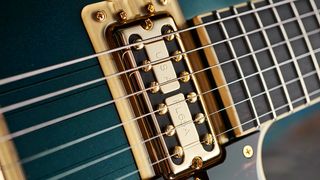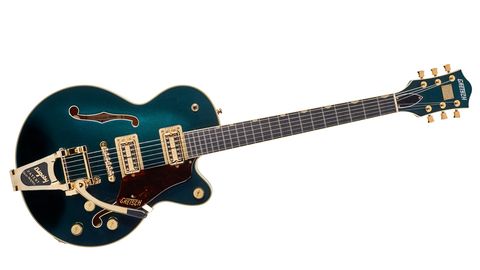Who doesn’t love the look of a Gretsch? They’re big, bold and flashy and they scream rock ’n’ roll - and that’s rock ’n’ roll of all flavours, from Eddie Cochran to George Harrison, Neil Young to Joe Perry, Billy Duffy to Johnny Marr and beyond.
Trouble is, play a classic 6120 or Duo Jet and it can seem a bit, well, old-fashioned. And while the likes of Brian Setzer, Darryl Higham and Richard Hawley couldn’t live without their own Gretsches’ quirky controls and 50s playability, a growing number of players desire the brand’s looks, sound and unmatched vibe, but also want something a tad more versatile and user-friendly.
Enter this latest Players Edition model with its neck set lower into the body for improved access, higher-output Filter’Tron-style humbucking pickup (Full’Trons) and a modernised Bigsby vibrato where through-stringing replaces the notorious ‘hooking the ball-end over a peg’ system that scuppered any chance of a quick change.

Mate these modern tweaks with another recent innovation (for Gretsch, at any rate), the Centre Block range, and you have a guitar ready to compete with anything out there - in virtually any style.
This model features a solid centre block (the block is spruce and, according to Gretsch, lighter and more toneful than maple), Full’Tron pickup, locking Gotoh tuner, Adjusto-Matic bridge and binding all round, including the f-hole. It has an exceptionally classy raised tortoid pickguard and the slightly simplified control layout of individual pickup volumes, single tone control, three-way selector and - the one remaining anachronism in our view - a master volume control mounted on the lower horn.
Gretsch model naming can be a little confusing so we asked our friends at Fender EMEA to clarify. “As with most Pro series Gretsches, each model variation is available in one colour,” they told us, “although you could think of the Broadkasters as three model types with different finish appointments: Jr, Hardtail and Bigsby models, with two or four finish options each. So, one price for flames, Bigsbys, goldplating or combinations thereof, and a lower price to forego those things.”
The Jr has a definite Gretsch-y look with its gold hardware, Bigsby, ebony ’board and cool gold Broadkaster headstock nameplate. (The Broadkaster name, of course, was originally used on a Gretsch drum kit and was the reason why Fender had to change the name of its early solidbody from Broadcaster to Telecaster, thus causing the nameless ‘Nocaster’ in the process). Build quality is stunning, the Cadillac Green of the Jr is a real head turner.
Feel and sounds
With its 305mm (12-inch) fingerboard radius and 22 medium-jumbo frets on slim C-section neck, this guitar feels fresh and comfortable in the hand. And the fact that the neck sits deeper in the body making the pickup protrude a good deal less, too, adds to this more modern feel (our orange 6120 seems almost archaic by comparison).
The thin body holds the guitar close to you, for an intimate and rewarding playing experience. Avoid looking in the mirror, though - we bet you can’t! As mentioned, a prime selling point is the all-new drive trains, the first new US-made Gretsch pickups since the 70s (Filter’Trons have been Gretsch’s humbucking mainstay since the 50s). They’re great-sounding units combining real punch with clarity and articulation - AC/DC’s Malcolm Young to Brian Setzer in The Stray Cats is a pretty broad spectrum.

For the Players Edition Centre Blocks, the Filter’Tron has become the Full’Tron, with greater output, punchier mids and a generally more up-to-date ethos. A clean setting on our ubiquitous Fender Blues Junior elicits a hard-edged twang from the bridge ’Tron, a warm but articulate jazz note from the neck, and a Duane Eddy-ish clunk in the middle (very DeArmond-like).
The Bigsby could be adding to or subtracting from the sonic soup, but without otherwise identical instruments side by side it’s hard to tell. ‘No-load’ tone pots mean that, when set wide open, the signal bypasses both pot and capacitor for the clearest possible tone, but knock it back from the notched ‘open’ position and it works like a normal control. Suffice it to say, this guitar leaves a very pleasing impression on the ears as well as the eyes.
“Who doesn’t love the look of a Gretsch?” this review began. Well, we think even more will be seduced by these updated and uprated models, enticing a whole new flush of members to the Gretsch gang with their vastly improved player comfort and a range of tones that can cover anything other than the highest-gain metal.
Japanese build quality is beyond reproach, and the range of options available means there’s something for everyone.

